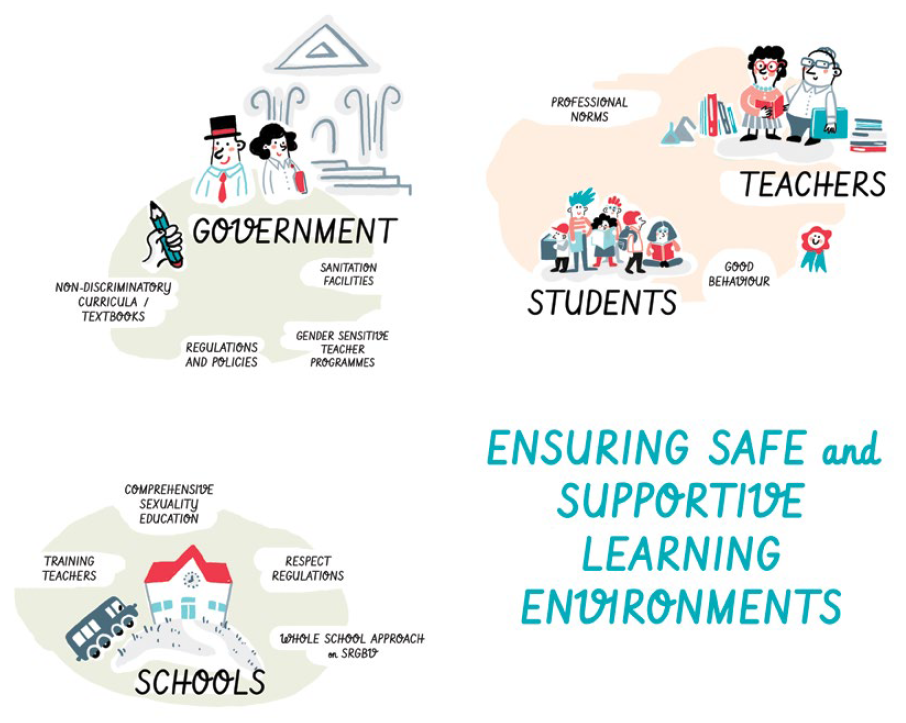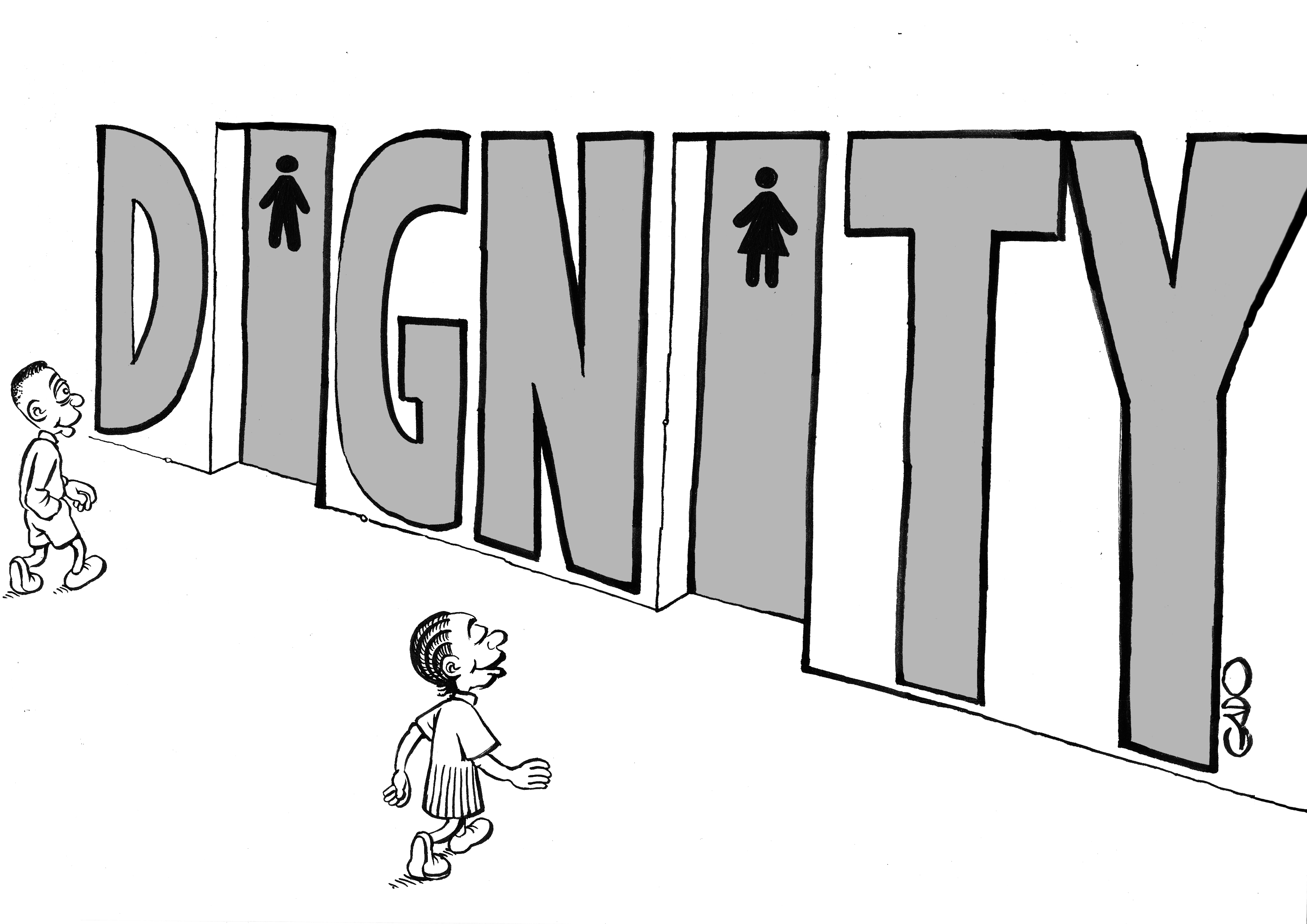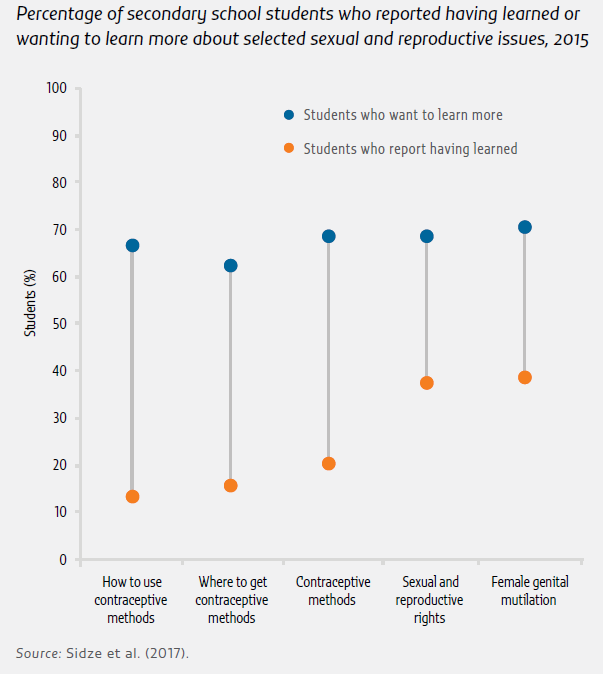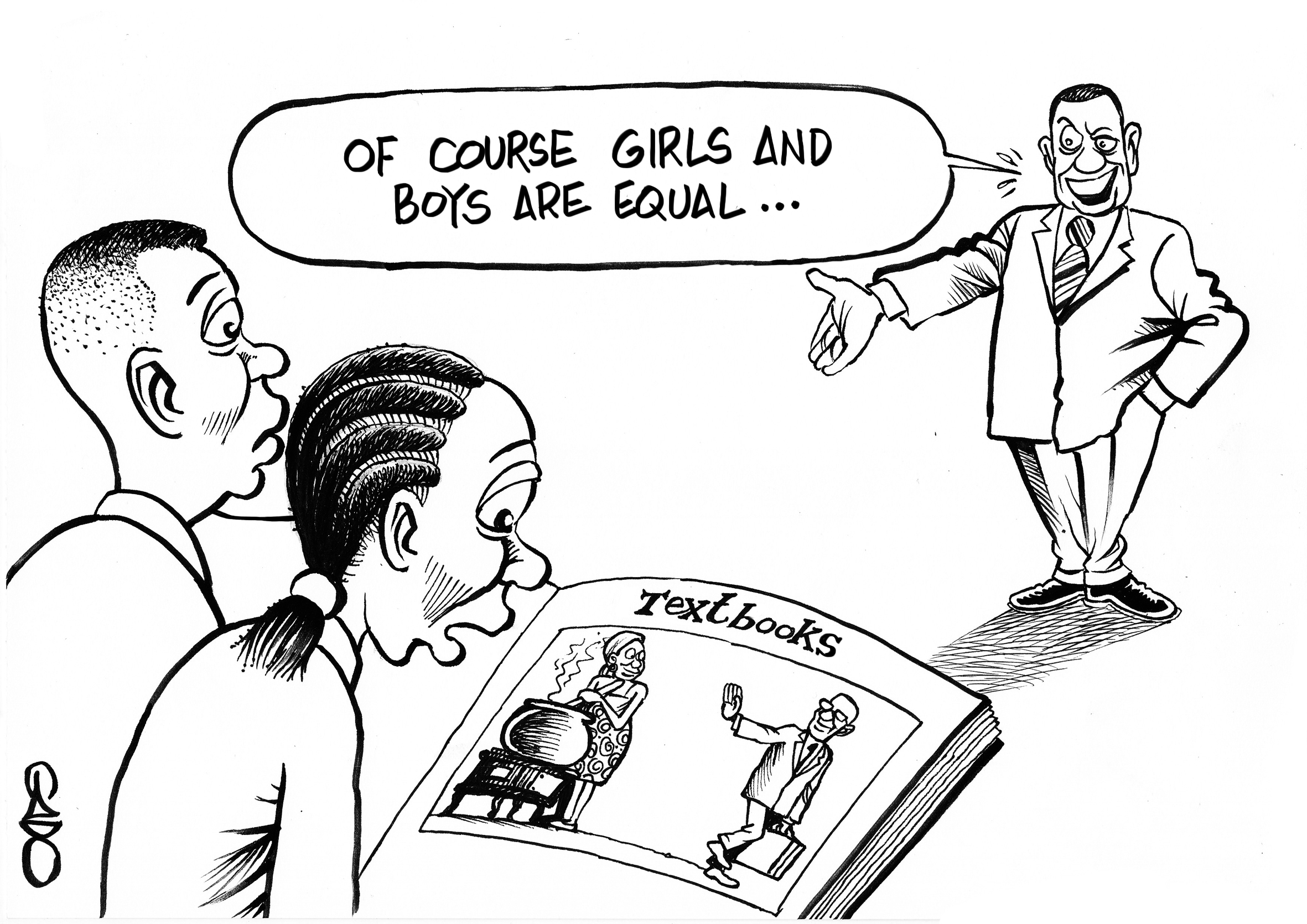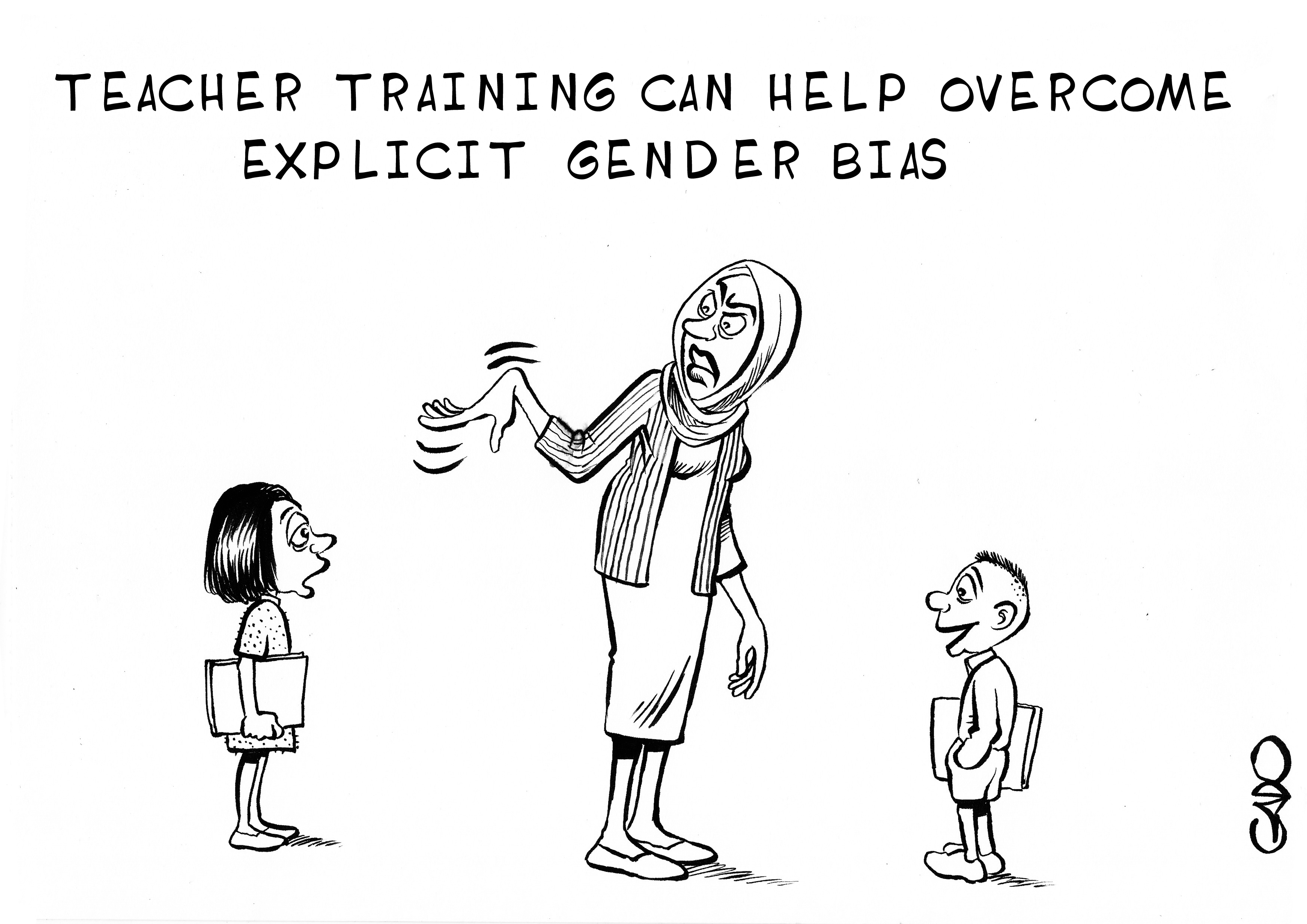Gender equality through school: providing a safe and inclusive learning environment
Boys and girls must feel welcome in a safe and secure learning environment. Governments, schools, teachers and students all have a part to play in ensuring that schools are free of violence and discrimination and provide a gender-sensitive, good-quality education (Figure 16). To achieve this, governments can develop nondiscriminatory curricula, facilitate teacher education and make sure sanitation facilities are adequate. Schools are responsible for addressing school-related violence and providing comprehensive health education. Teachers should follow professional norms regarding appropriate disciplinary practices and provide unbiased instruction. And students must behave in a non-violent, inclusive way.
NATIONAL AND SCHOOL POLICIES SHOULD TARGET SCHOOL-RELATED VIOLENCE
School-related violence is a pervasive issue in some countries. Violence can be physical, psychological or sexual; it can occur on school grounds, in transit or in cyberspace; and it may include bullying, corporal punishment, verbal and emotional abuse, intimidation, sexual harassment and assault, gang activity and the presence of weapons among students. It is often perpetrated as a result of gender norms and stereotypes and enforced by unequal power dynamics. It was estimated that, globally, approximately 246 million girls and boys experienced some form of school-related violence in 2014 (UNGEI, 2017).
While the vast majority of teachers are caring professionals who put the best interest of their students first, some abuse their position of power. In West and Central African countries, sexual abuse and exploitation by teachers, school staff and others in position of authority is common practice (Antonowicz, 2010). Sexual violence happens frequently in many schools in South Africa but crimes are rarely investigated and prosecution rates are low (HRW, 2016). In the United Republic of Tanzania, over half of girls and boys who had experienced physical abuse identified a teacher as an abuser (HakiElimu, 2017). In Samoa, 41% of children surveyed in 2013 indicated that they had experienced violence at the hands of their teacher (Office of the Ombudsman and NHRI Samoa, 2015).
Some countries, including Chile, Fiji, Finland, Peru, the Republic of Korea and Sweden, have passed legislation on violence in educational institutions (UNESCO, 2015c, 2017b). The 2013 Anti-Bullying Act in the Philippines requires all schools to adopt policies to prevent and address acts of bullying. It explicitly refers to gender-based bullying, which is described as any act that humiliates or excludes a person on the basis of perceived or actual sexual orientation and gender identity. Yet in the following year just 38% of schools had adopted child protection or anti-bullying policies. The low rate highlighted a lack of communication and a weak monitoring framework.
The Department of Education responded by issuing a memorandum to clarify submission requirements and is working to build implementation capacity (UNESCO, 2015c). Teacher education and codes of conduct can help change teacher attitudes and behaviours. In South Sudan, the UNICEF Communities Care programme engaged with teachers to challenge norms that enable sexual violence and brought about some shifts in teacher attitudes and behaviours (UNGEI, 2017). The Doorways programme in Burkina Faso, Ghana and Malawi trained upper primary and lower secondary school teachers on children’s rights and responsibilities, alternative teaching practices, basic counselling and listening skills, awareness of sexual harassment at school and teacher code of conduct (DevTech Systems, 2008; Queen et al., 2015). The Communication for Change project trained teachers in the Democratic Republic of Congo to act as first responders when they witnessed school-related gender-based violence. The share of participating teachers who were aware of how to prevent gender-based violence in school increased from 56% to 95% after the intervention (C-Change, 2013). Teacher codes of conduct are generally written by teacher unions to guide their members. They promote professional accountability by giving peers a way to hold each other to account for adhering to norms (Poisson, 2009). A recent survey by Education International found that teacher codes of conduct were present in 26 of 50 countries surveyed (EI, 2017). A separate review of 24 countries found that over half of teachers believed the code of conduct had a very significant impact in reducing misconduct (McKelvie-Sebileau, 2011).
Teacher codes of conduct can be effective in reducing school-related gender-based violence if they explicitly refer to violence and abuse and include clear breach reporting and enforcement protocols. Mongolia’s Teachers Code of Ethics for General Education Schools and Kindergartens contains a section on teacher ethical norms, which specifies that teachers should protect student’s health and well-being, including from sexual abuse, and should ensure equal participation without discrimination, including on the basis of sex (Steiner-Khamsi and Batjargal, 2017). Kenya has a range of penalties for breach of professional conduct, including suspension and interdiction. Teachers convicted of sexual offences against students are deregistered (Kenya Teachers Service Commission, 2013). However, even when they exist, these codes are not always successfully disseminated.
The implementation of Ethiopia’s Code of Conduct on Prevention of School-Related Gender-Based Violence in Schools has been patchy. Some school staff reportedly lacked commitment to or a sense of ownership of the code (Parkes et al., 2017). Students are also responsible for ensuring their behaviour does not impinge on others’ right to education (UNICEF and UNESCO, 2007). Schools are increasingly implementing prevention-oriented models to teach students acceptable strategies for interacting with their peers (Horner et al., 2010). These models set clear guidelines for students and define consistent instruction, record-keeping and follow-up procedures for teachers and other adults, such as administrative and custodial staff, playground supervisors, cafeteria workers and parent and community volunteers (Lewis et al., 2014).
Students are more likely to show positive social behaviours and reduce negative behaviours after the implementation of such programmes (Durlak et al., 2011). There is also increasing evidence linking improved social skills to academic achievement (Horner et al., 2010). While these codes of conduct are mostly used in Europe and North America (Sklad et al., 2012), Asian countries such as Singapore have also begun adopting them (Durlak et al., 2011).
GENDER-SENSITIVE FACILITIES CAN INCREASE THE TIME GIRLS SPEND IN SCHOOL
Inadequate sanitation facilities for girls during menstruation can have a negative effect on school attendance. Among 145 countries with data, primary school access to basic sanitation facilities was below 50% in 28 countries, 17 of them in sub-Saharan Africa. Only limited data are available on whether girls have separate facilities, let alone whether the facilities are functional or well maintained. In only 9 of 44 countries did more than 75% of primary schools have single-sex facilities; in Benin and Comoros, under 5% of schools had single-sex facilities. An estimated one in ten African girls miss school during menstruation (HRW, 2016).
Regulations requiring separate toilet facilities for boys and girls can help. Yet analysis of regulations in 71 education systems by the GEM Report team shows that only 61% required sex-separate facilities for public schools and 66% for private schools (UNESCO, 2017a). Regulations alone are not sufficient to ensure facilities are available. Although separate sanitation facilities are mandated by regulations in Bangladesh, a survey found that in 2014 only 12% of girls reported access to female-only toilets with water and soap available. Combined with a lack of waste bins, the poor facilities contributed to girls missing school during menstruation. Two in five girls were absent during menstruation for an average of three days during each cycle (Alam et al., 2014). Girls in Haiti have reported having to go home to change the materials they use to manage their menstruation, resulting in lost instructional time (HRW, 2016).
School inspections play a key role in ensuring that schools adhere to regulations. However, inspections do not always take gender issues into account. In Sweden, the school inspectorate takes gender equality into consideration (Heikkilä, 2016) and in the United Kingdom inspectors evaluate equal opportunities in the classroom and whether the school provides an inclusive environment for boys and girls (Rogers, 2014). By contrast, gender issues are rarely included in inspections in Bangladesh, with sex-separate sanitation facilities only occasionally observed (Chatterley et al., 2014). In any case, inspectorates are severely constrained by human resource shortages in many poor countries. For instance, in Mvomero district, United Republic of Tanzania, although 80% of schools are supposed to be inspected annually, only one in five schools were inspected in 2013 (Holvoet, 2015).
GENDER EQUALITY IN EDUCATION REQUIRES UNBIASED CURRICULA AND TEXTBOOKS
To facilitate gender-responsive instruction, curricula and textbooks should be free from gender bias and promote equality in gender relations. How students perceive themselves and how they project their role in society is shaped to some extent by what they experience at school, including by how they are represented in textbooks.
Comprehensive sexuality education
School-based comprehensive sexuality education programmes equip children and young people with empowering knowledge, skills and attitudes. In many contexts, programmes focus almost exclusively on HIV as a motivator to encourage students to delay sexual activity and have fewer sexual partners and less frequent sexual contacts (Fonner et al., 2014). However, international guidelines and standards, along with emerging evidence about factors influencing programme effectiveness, increasingly stress the value of a comprehensive approach centred on gender and human rights (Ketting and Winkelmann, 2013). A review of 22 studies showed that comprehensive sexuality education programmes that addressed gender power relations were five times more likely to be effective in reducing rates of sexually transmitted infections and unintended pregnancy than those that did not (Haberland, 2015).
In 2009, UNESCO and other UN agencies published the revised International Technical Guidance on Sexual Education to provide an evidence-based, age-appropriate set of topics and learning objectives for comprehensive sexuality education programmes for students aged 5 to 18 (UNESCO, 2009). In 2010, the International Planned Parenthood Federation adopted a rights-based approach in its Framework for Comprehensive Sexuality Education, and the WHO Regional Office for Europe produced Standards for Sexuality Education in Europe as a framework for policy-makers and education and health authorities (WHO Regional Office for Europe and BZgA, 2010). Nearly ten years after the original report, UNESCO’s revised guidance expands coverage to both school-based and out-of-school programmes with a strong focus on human rights, gender equality and skills building. The guidance can act as both an advocacy and accountability tool for programme implementers, NGOs, and youth (UNESCO, 2018).
A 2015 review of the status of comprehensive sexuality education in 48 countries found that almost 80% had supportive policies or strategies. Despite this political will, a significant gap remained between policies and implementation (UNESCO, 2015b). In western and central Africa, UNESCO’s Sexuality Education Review and Assessment Tool was used to assess 10 out of 13 national sexuality education programmes. Fewer than half the curricula met global standards for required content for all age groups, with gender and social norms identified as the weakest areas (Herat et al., 2014; UNESCO and UNFPA, 2012).
Recent studies in Ghana and Kenya provided evidence of gaps in content and delivery. The Kenya study covered 78 public and private secondary schools. While 75% of teachers reported teaching all topics of a comprehensive sexuality education programme, only 2% of students reported learning all topics. Only 20% learned about types of contraceptive methods, and even fewer learned how to use and where to get them (Figure 17). In some cases, incomplete and sometimes inaccurate information was taught. Almost 60% of teachers incorrectly taught that condoms alone were not effective in pregnancy prevention (Sidze et al., 2017). Moreover, 71% of teachers emphasized abstinence as the best or only method to prevent pregnancy and sexually transmitted diseases, and most depicted sex as dangerous or immoral for young people.
Barriers to effective implementation of comprehensive programmes include lack of well-trained teachers, poor support of schools, weak regulation and supervision of policy implementation, opposition from religious and conservative groups, and culturally imposed silence about sexuality. In the Ghana study, 77% of teachers reported lacking resources or teaching materials. A smaller share reported conflicts, embarrassment or opposition from the community or students on moral or religious grounds (Awusabo-Asare et al., 2017).
Textbooks increasingly cover gender issues but progress is insufficient
Self-reporting from governments in Cuba, Estonia, Finland, Mexico, Nicaragua, Slovenia and Spain indicates that gender equality is integrated into national school curricula (UN Human Rights Council, 2017). The Ministry of Education, Culture, Science equality as one of the key values in its new core curriculum (Steiner-Khamsi and Batjargal, 2017).
Over the past 50 years, mentions of women and women’s rights in textbooks have increased (Bromley et al., 2016; Nakagawa and Wotipka, 2016). Nevertheless, in many countries women remain under-represented or, when included, are relegated to traditional roles such as housework and childcare (UNESCO, 2016a). Women accounted for only 37% of images in primary and secondary school textbooks in the Islamic Republic of
Iran in 2006–2007 (Paivandi, 2008) and across nine Jordanian secondary school history books only 21% of images were female. From Sweden to the Syrian Arab Republic, despite governments explicitly identifying the importance of gender equality in textbooks, women and men were still routinely portrayed in a stereotypical manner (Bromley et al., 2016).
Both governments and civil society can act to reduce textbook biases. The Human Rights Council has made it clear that ‘states have an obligation to periodically review and revise curricula, textbooks, programmes and teaching methods to ensure that they do not perpetuate harmful gender stereotypes’ (UN Human Rights Council, 2017). Some states include an explicit gender analysis as part of their textbook and review process. In Viet Nam, the National Strategy on Gender Equality for 2011–2020 specifies that textbook content should be reviewed for gender stereotypes (UNESCO, 2016c). In Ghana, the Textbook Development and Distribution Policy for Pre-tertiary Education included gender sensitivity as one of the main criteria for evaluating textbook proposals (Ghana MOE, 2001). By contrast, the Pakistan National Textbook and Learning Materials Policy and Plan of Action does not mention gender as a criterion of textbook review, referring instead to ‘quality of content, presentation, language and specific provincial coverage’ (Pakistan MOE, 2007).
Textbook monitoring by parents and civil society can be effective. In South Africa, a parent’s question posted on Facebook in July 2016 inspired a petition that ultimately led the textbook publisher to amend and issue an apology for content that promoted blaming the victim for sexual assault (Davies, 2016).
TEACHER EDUCATION CAN HELP ADDRESS UNDERLYING GENDER BIASES
Aside from the influence of official curricula and textbooks, teacher practice in the classroom is partly shaped by their assumptions and stereotypes about gender, which in turn affects students’ beliefs and learning. In
Australia, female teachers felt particularly responsible for boys’ underachievement relative to male teachers (Hodgetts, 2010). In the United States, anxiety expressed by female mathematics teachers was associated with female students’ belief in the stereotype that boys are better at mathematics (Beilock et al., 2010).
Teacher education can assist teachers to reflect on and overcome their biases. Formal initiatives in teacher education with a focus on gender have taken place in Italy, the Republic of Moldova and Sudan (OHCHR, 2015). In Spain, the University of Oviedo requires teacher candidates to complete a mandatory course on gender and education (Bourn et al., 2017). In Ankara, Turkey preservice teachers that took a semester long course on gender equity in education developed more gender sensitive attitudes (Erden, 2009).
In low and middle income countries, teacher education programmes are often externally funded. The UNESCO Regional Bureau in Bangkok has recently funded a five-year project, Enhancing Girls’ and Women’s Right to Quality Education through Gender Sensitive Policy Making, Teacher Development and Pedagogy, which focuses on training participants from Cambodia, Myanmar, Nepal, Sri Lanka and Uzbekistan to conduct gender assessments in teacher education (UNESCO, 2016b).
In Karamoja region, Uganda, the UNICEF Gender Socialization in Schools programme trained over 1,000 primary school teachers to enhance their knowledge, attitudes and practices related to gender equality promotion and conflict resolution. The initial training lasted for two days and was followed by two refresher training sessions. A subset of teachers received reinforcing text messages reminding them of examples of good practice. However, while the programme improved teachers’ knowledge and attitudes on gender equality, classroom practices did not become more gender-responsive (American Institutes for Research and UNICEF, 2016; El-Bushra and Smith, 2016).
Nigeria updated its teacher education curriculum in 2012, in part to address gender issues (Unterhalter et al., 2015). While a policy is in place to ensure minimum standards on gender equality, a survey of 4,500 student teachers in 2014 showed that very few had an in-depth understanding of what gender equality in education might mean, while many were hostile to women’s participation in public life and any form of social engagement. Among respondents employed following graduation, teachers reported receiving no professional development on gender, a point echoed by other colleagues at the schools where they taught. Teachers who had the most egalitarian ideas about gender reported themselves the most frustrated of respondents and said that they were unable to put their ideas into practice (Unterhalter et al., 2017).
The examples from Uganda and Nigeria highlight some of the challenges in changing teacher practices. To be effective, teacher education and training need to be continuous to recognize the time it takes for such practices to change. They also need to incorporate other stakeholders to help build a more supportive environment.


